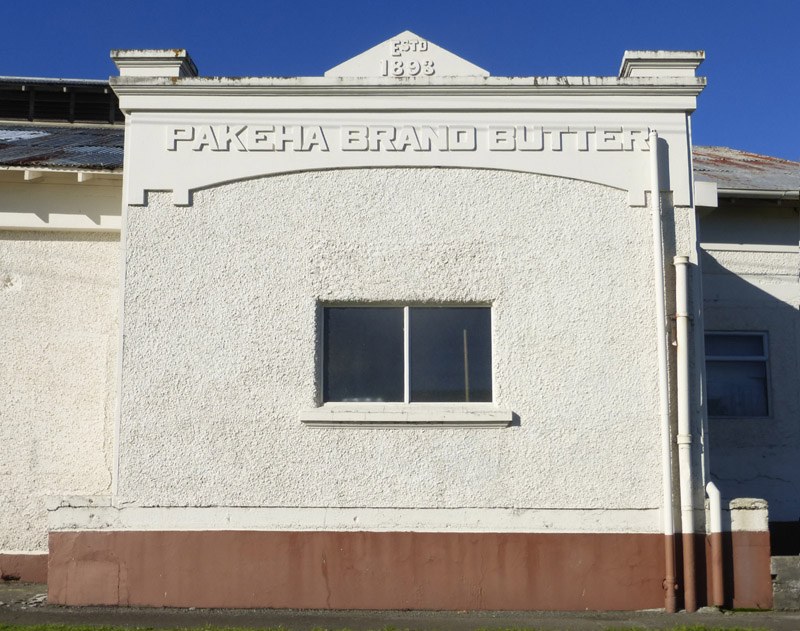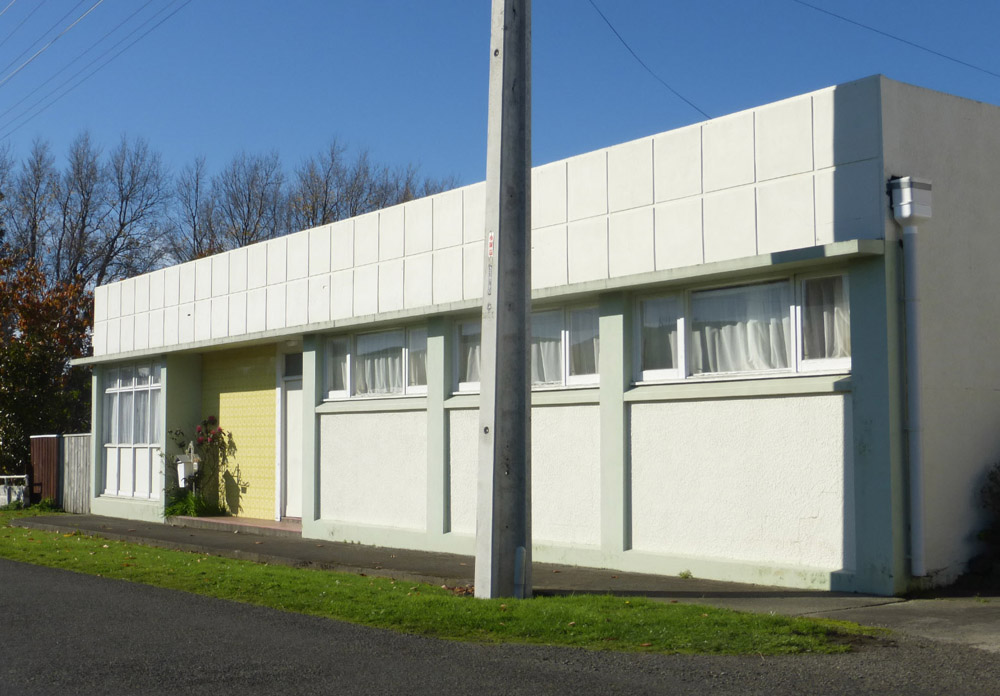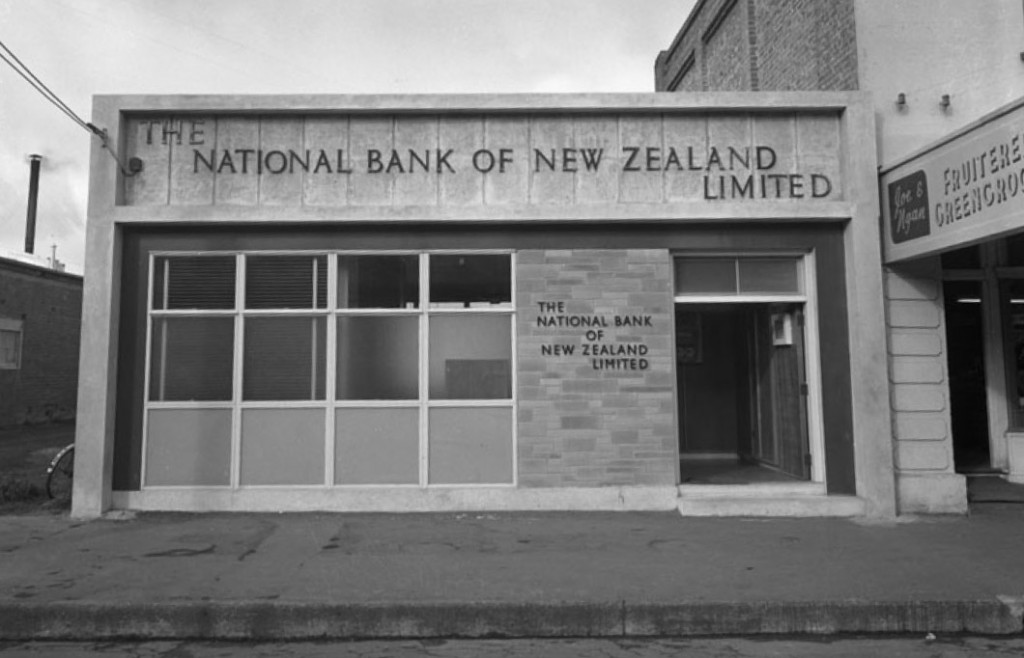A slight detour this week away from Wellington, on an exploration up country. I went to Feilding, not entirely sure why, and on trying to escape, found myself at a most remarkably named Co-Operative Dairy – the Pakeha Butter Company of 1893. I was intrigued, because I had thought that the name Pakeha was more of a 20th Century tag for white folk, rather than 19th Century, and on consulting the oracle (wikipedia) I find that it was indeed a name in common usage over a hundred years ago. Wikipedia assures me that the term is not a derogatory one, and that it has come to mean not just “white people”, but more: “non-maori”. I have a friend who vehemently dislikes being termed and defined by something he is not – ie a term meaning non-maori is derogatory (to him), but then again, isn’t that just the same as a fe-male being by definition not a male? Hmmm. And so if not exactly meaning “white”, then do Chinese New Zealanders think of themselves as Pakeha? Or just New Zealanders? Or, like the 7% of us in the last census who apparently put down “kiwi” as their ethnicity? Heavens to Murgatroyd, its all just too complicated. Thankfully we don’t have the problems of Iraq, which has now completely lost me with Sunni, and Shia, and Fundamentalists, and the whole caboodle. All the more reason to keep Colin Craig well away from the ballot-box and to keep NZ strictly secular.
Wait – did I get off topic there? Just a little, it seems…. So, back to the architecture:

Of even more joy, just next door, and painted the same colour – so evidently part and parcel of the same dairy at one stage or another – is this delightful mini-modern version of the dairy, now probably someone’s house. My guess: somewhere around 1940 ? Simple, clean, and oh-so financially minimal, it’s not alone in the provinces as a modernist work. Gleaming yellow tiles the colour of a freshly churned pat of butter: architecture good enough to lick (almost). Was this designed by someone, a returned services person perhaps, who had seen modernism underway after WWII and wanted to bring a little of that home to the Manawatu? I like to think so.

But it is not just restricted to Feilding. There is a marvelous little Four Square store in Rongotea, which really is one of those places in the middle of nowhere – too small (almost) to find on a map. I’m willing to wager that it wasn’t built originally as a Four Square, but its name plate certainly looks authentic: “Food Store”. The yellow and green livery certainly screams it now, along with its sleek 1940s streamlined modernism.

Otherwise though, small town mittel-zeeland seems to be still a staunchly colonial, wild-west type frontier town, at least in terms of the architecture. Gabled timber facades loom large. Rusty iron roofs around the side, aging totara weatherboards to the fore, paint long since forgotten. Its harsh out there ins small town new Zild.
I’m sure however that there are more modernist marvels hidden away in small town Aotearoa, like those glimpsed above. Any more you’d like to mention? Got a favourite you’d like to share?
Post-Script updated 18 June 2014:
Following on from the discovery (thanks to GreenWelly) of the Wonderful photo archive at Feilding, I’ve added in another couple of modernist mini-marvels – both sadly gone, I think. A tiny wee modernist National Bank in Feilding, and then a far more grand and almost exciting looking Post-Office in Feilding. Nice! Thanks to Feilding Library online!

…






“… a term meaning non-maori is derogatory… but then again, isn’t that just the same as a fe-male being by definition not a male?”
I’d say that a word in itself is not necessarily derogatory. It’s the intention and context that gives it a loaded meaning. When African-Americans call each other the N-word it can be in a very non-derogatory way. Likewise, ‘gay’ ‘faggot’ or ‘queer’ are words that are used by both homosexuals (and their straight friends) and bigots alike.
As for ‘female’, I’m afraid that was poor choice for as an example.
OED says:
“ORIGIN Middle English: from Old French femelle, from Latin femella, diminutive of femina ‘a woman’. The change in the ending was due to association with male, but the words male and female are not linked etymologically.”
Personally, Pakeha doesn’t really bother me although I’d rather live in a world without labels. As far as I’m concerned we’re all mongrels of one sort or another.
Broadway, the main street of my hometown Marton, is full of beautiful old (but perhaps not modernist) buildings, interrupted only by a horrifically blank Woolworths, which has no shame about what it does to the townscape.
Josh, thanks for that info – I’m glad to hear that the words male and female are not linked etymologically, albeit somewhat surprised. And exactly, living label free is alright by me too. Indeed, I find it strange how some people find it enjoyable not just to enthusiastically label themselves, not just ethnically but also physically. I’m one of those people to who even a logo for Nike on a shirt is irritating, but I will even actively unpick labels on clothes where I can. Why do I need a large leather patch saying Levi or Wrangler or Just Jeans on my arse? I don’t get it.
Lindsay – Marton is a funny place. I think i went on the main road and missed it – tragic, i know – but all the buildings look like 1920s buildings, from my brief google-streetview search. Almost uniquely so. There are many places in NZ with Victorian frontages, and some with Colonial, but is Marton all Edwardian, in the way that Napier is all Art Deco?
I wonder…
re your comments on labelling – i’ve always wondered why it is that people would want to buy replica sports jerseys, especially those covered with adverts for the official team sponsors. It is one thing to be wearing a team (black) jersey with a discrete Adidas logo (and a less discrete AIG one), but it is quite another thing to be plastered with logos for every business under the sun. I can understand why the teams have to do it – but if YOU pay money to buy a jersey which is already sponsored – you’re not being paid for the sponsorship, you’re actually paying the sponsor for the joys of them having free advertising all over you! Madness! Sheep!
re Alan, when companies like Adidas and AIG sponsor a team merchandising is taken into account, if replicas didn’t have the team sponsors on them then sponsors would pay less to the team. You are being paid for wearing it, just you are agreeing that it goes to that team.
It would be nice to have a society that didn’t require us to beg corporations for pennies to fund sports and arts in exchange for help to perpetuate their near monopolies, but our current society obviously (or obliviously) doesn’t seem to think its a big deal.
Your “Food Store” in Rongotea was actually built in the 1950s as “Steve Claasen’s Foodstore” complete with lovely cursive naming script :)
a bit of googling turned up the following
http://feildingphotos.mdc.govt.nz/nodes/view/17405
The handrail/hitching rail is original, not bad for something built nearly 60 years ago…
green welly, you’re a star ! “Steve Claasen’s Foodstore†is lovely! Hmmm, 1950s eh? OK, so now we need to find out who the actual architect was….
And greenwelly, you’re just the gift that keeps on giving really, aren’t you? I just found this link:
http://feildingphotos.mdc.govt.nz/nodes/view/16425
The notes record that:
“Discussion commenced on 9th March 1893 re the Cheltenham Co-operative Dairy Company Limited …. It was also decided at this meeting that the Company would produce butter rather than cheese.
A site was chosen for the proposed dairy factory, opposite the Cheltenham Hotel, on the main road. A decision was made by the firectors to take pigs in any quantity all year round…… It was also decided at the above-mentioned meeting that the registered brand would be named “Pakeha”.
The internet has a lot to answer for, there’s no mystery left in the world. The Rongotea (originally named Campbelltown, like Bluff was – thanks, internet) is NOT a listed heritage item in the Manawatu District Plan. I wonder if heritage architects (is that what they’re called? I guess the internet would tell me…) under-appreciate modernist architecture? There’s a couple of buildings in Wellington that are listed (Pastoral House?) but not a lot I expect.
Thank you Chico for that – I didn’t know that about Campbelltown. I also didn’t even know there was a Cheltenham in / near Feilding. There’s evidently a lot I don’t know…
And re heritage architects liking modernist architecture? Absolutely, more than you would know. Julia Gatley is a leading example, even if she is an Aucklander, but there are many others down here. In fact, the recently departed Bill Toomath was both a modernist, and an architect, and keen on heritage, all rolled into one adorable little ball. Can’t ask for more than that.
>>lindsay
Broadway, the main street of my hometown Marton, is full of beautiful old (but perhaps not modernist) buildings, interrupted only by a horrifically blank Woolworths, which has no shame about what it does to the townscape.<<
Try these:
http://goo.gl/maps/jCJlv
http://goo.gl/maps/4BNO7
http://goo.gl/maps/2FjMU
http://goo.gl/maps/2pcZM Take a look to the right of this building for one of Marton's newest Main Street buildings!: http://goo.gl/maps/GQORY
http://goo.gl/maps/XMQ7X
http://goo.gl/maps/i354I This one's kind of sweet…
…but across the road is this!? http://goo.gl/maps/8kON6
Oops – that last post was all me… Here’s another small town gem:
http://goo.gl/maps/Ywzhd
But better seen in the original here: http://horowhenua.kete.net.nz/image_files/0000/0010/4127/SC2800929812081316410.jpg
Also, some nice interior shots here…
Bill Alington was the architect of this one, for Gabites and Beard in the mid-60s.
Gatley and her wonderful publication are a big breath of fresh air into NZ’s “modern heritagism” – is that even a valid term.
It is a shame that NZ’s brutalist ministry of Works never got round to building something like the geisel library, I think NZers views of modern heritage buildings would be far more accomdating if they had….
I meant publications, damn fat fingers,
Thanks Greenwelly for the links into the Geisel – by heck, that’s a feat and a half of engineering, isn’t it? (a link here for those of you that don’t know what greenwelly is talking about… http://archaesthetic.tumblr.com/image/50896750060 ) quite superb – quite mad really too!
and m-d thank you too for that series of linkages through the hidden depths of the talents of the Manawatu Modernism from the mid-50s. How do you do that short link thing? when i go to google streetview, i get a link that is half a million miles long. Like this:
https://www.google.co.nz/maps/@-40.078359,175.379184,3a,75y,180h,91.45t/data=!3m4!1e1!3m2!1sOgSjnnjOtqDMZVx_whJhLw!2e0
And while we’re on the subject of google, i’m getting really irritated with their deliberate fuzzing of features. It started out just a blur on car rego numbers, then people’s faces, but now it seems to be random words as well. For instance, in the link above, I’m presuming that particular green “modern” marvel once said “Housing Alterations – Custom Built Kitchens / Bathrooms” but they appear to have deleted the word Kitchen from that heading. Why? It can’t be a rude word or a phone number in there – why delete that word? Strange…
Also, and rant rant rant, the streetview time roll back feature works perfectly in Marton and Feilding, where, let’s face it, nothing much really ever changes (sorry Lindsay), but when i go to Christchurch and look there, it is just stuck. Or is that just me? (checks again – working now) – No, it’s just me.
I can’t work out how produce the short URL links from the new Google Maps, but if you revert back to the classic version, you can obtain the shorter links from the link tool in the top left of the screen (near the compass):
I forgot this Marton masterpiece too, just across the Tutaenui from that green marvel: http://goo.gl/maps/G8mNn
It is the old PEC building – Production Engineering Co. The interwebs don’t shed any light on that long-gone institution, but it was once the pride and joy of Marton’s technological superiority (I remember well, my primary school visits there). They made early electronic petrol pumps among other things…
I like this building, as it shows an older wing to the left of the entry, and a newer version on the right. I have no idea what t he Modernistic white building is on the end though…
So, could Marton be the capital of middlenz Modernism??
(PS I forgot to mention that my previous post is from Shannon, in case it needed clarifying :)
m-d : Tutaenui ? Really? is that a real name? For a name of a river in what is now one of the more polluted areas of the country (water-wise) then for the maori to call something the Tutaenui seems rather prescient.
So – you and Lindsay, both from Marton then eh? I’m sure that there is probably some witty line of repartee I could come up with, but I’ll withhold and just say… Nice.
Yep – Tutaenui is consistently in the worst 25% in stats for polution according to here: http://www.lawa.org.nz/explore-data/manawatu-wanganui-region/rangitikei/tutaenui-stream-at-us-marton-stp/
@m-d Prodcution Engineering in Marton was very much a PI ( pre internet) company, you will find very few online references,
It was gobbled up in 1999 by gallaghers,
http://www.nzherald.co.nz/business/news/article.cfm?c_id=3&objectid=10803467
There are a few references to it in the national Library, but nothing on line
http://natlib.govt.nz/items?utf8=%E2%9C%93&il%5Bprimary_collection%5D=Index+New+Zealand&text=production+engineering+marton
According to teh interwebz:
For three years the small village was known as Tutaenui, named after the stream running through its centre. In 1869 local citizens changed the name to Marton to honour the home village of Captain James Cook in Yorkshire, marking his landing in New Zealand exactly 100 years earlier. It is not known if this change of name was influenced by the mistranslation of ‘tutae’ (meaning ‘dung’) and ‘nui’ (meaning ‘large’).[1] (Actual translation: ‘tu’ -stand, ‘tae’ -arrive, ‘nui’ big; i.e., a ‘big gathering’).
The more you know…
Seamonkey – are you sure that isn’t just post-colonial justification? Not everyone wants to be from a town called Big Poo, but I have a feeling that the Maori back then were not ones to mince their words…. seeing as the area is so flat, and the stream probably always was a little lazy, I’d believe that it was always a bit of a smelly river.
There’s also the Tutaekuri river in Hawkes Bay, which is just literally Dog-shit river, and the locals over there haven’t tried to post rationalise it to something else… just sayin…
@maximus, And then there is the whole Te Urewera thing
greenwelly – there is? I’m unsure – what do you mean?
You mentioned Tutakuri river as meaning Dog-shit river, in the context of Moari names that have translations that are less than flattering,
Urewera means “burnt penis” after a Maori chef rolled over a little to close to the fire one day….
Aaah, of course, now you remind me, that does sound familiar. Much the same reason as to why Levi removed the copper stud from the crotch of their jeans, due to complaints from cowboys warming themselves by the fire…
The most surprising building to me in that area is the old glaxo factory in Bunnythorpe — who would have thought Bunnythorpe, of all the places, would give birth to a company that after many many mergers would be the fourth largest on the London stock exchange?
Really? Hold on – did I venture all the way into the Manawatu, and forget to visit Bunnythorpe? Where is it? I must consult a map…. be right back
Oh, there! Gosh, yes, missed that one. Bugger. Will have to go back….